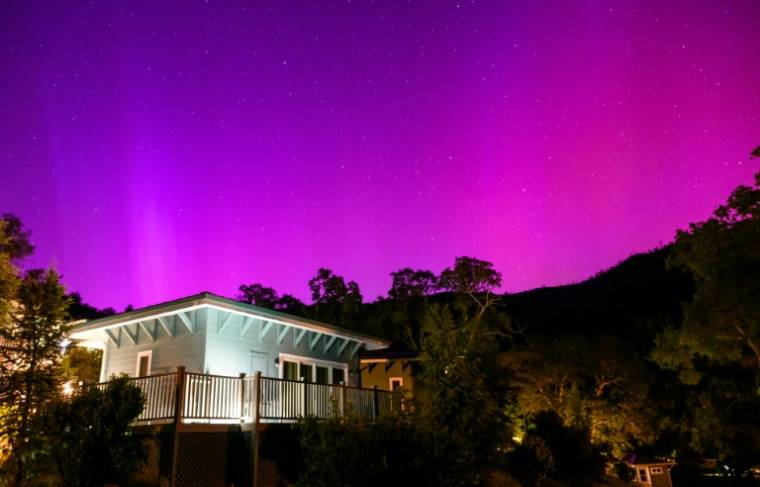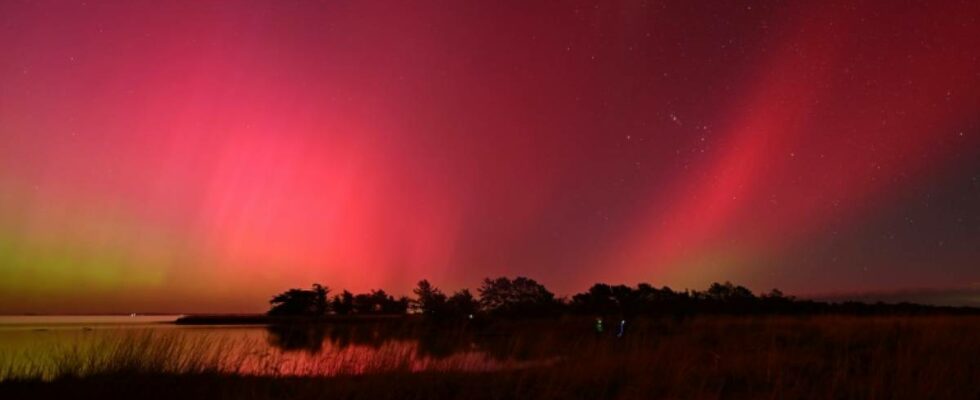Aurora borealis above Lake Ellesmere, near Christchurch in New Zealand, May 11, 2024 (AFP / Sanka Vidanagama)
Impressive northern lights are expected to once again ignite the sky on Saturday and Sunday, the consequences of an “extreme” solar storm which began to hit the Earth at the start of the weekend, also raising fears of disruptions to electricity and communications networks .
This storm is caused by a series of mass ejections from the solar corona.
From Tasmania to France, from Saturday morning, photos of the Northern Lights taken by amateurs and professionals flourished on social networks, accompanied by amazed comments.
“Words fail me to describe this fabulous spectacle in the sky this night (…) Northern lights of all colors and visible to the naked eye danced in the sky facing Mont Saint-Michel following an extremely geomagnetic storm strong!”, writes French photographer Mathieu Rivrin on Facebook.
“I have the feeling of experiencing a historic night in France (…) It was really full of solar particles and emotions”, underlines Eric Lagadec, astrophysicist at the Côte d’Azur Observatory, on the social network And “since I’m asked: yes, there is a chance of auroras tonight again. Find good spots, far from the lights, with a clear view to the north!”, advises this dust specialist. stars.

Aurora Borealis north of San Francisco, May 11, 2024 (AFP / JOSH EDELSON)
Conditions linked to a level 5 geomagnetic storm, the maximum level on the scale used, were observed Friday evening, announced the American Oceanic and Atmospheric Observing Agency (NOAA).
The storm is expected to continue at least until Sunday, with the arrival of additional coronal mass ejections, NOAA said Saturday on high frequency communications and GPS” had been reported.
China’s National Space Weather Center also issued a red alert on Saturday, warning that the solar storm is expected to continue through this weekend and is expected to impact communications and navigation systems, according to the Xinhua news agency, which reports that northern lights have been observed in the northern half of the country.
– The whole weekend –
This storm is due to “explosions of energetic particles and magnetic fields coming from the sun,” explained Shawn Dahl of the Space Weather Prediction Center (SWPC), attached to NOAA, at a press conference on Friday.
“None of the individual solar flares that have occurred over the past few days have been particularly impressive in terms of speed or size. But there has been such an uninterrupted series that they have all blended together in space and produced the first ‘super-storm’ in more than 20 years,” Mathew Owens, professor of space physics at the University of Reading, told AFP.
This type of storm first affects the latitudes around the poles but “the stronger the storm, the lower it goes in terms of latitude”, he explained to AFP.
In the United States, northern lights should be able to be seen over most of the northern half of the country, according to NOAA, and perhaps as low as Alabama or northern California.
Even if no aurora borealis is apparently visible, “go out into your backyard and take a photo with a recent smartphone, you will be amazed at what you see!”, advised AFP Brent Gordon, head of the space weather services branch of NOAA.
The last event reaching level 5 was in October 2003, an episode nicknamed “the Halloween storms”. At the time, power outages occurred in Sweden and transformers were damaged in South Africa.
The Sun is currently close to its peak activity, according to a cycle that returns every 11 years.
These coronal mass ejections, of which at least seven have been observed directed towards Earth, come from a sunspot approximately 17 times the diameter of Earth. They move at several hundred kilometers per second.

An aurora borealis above the National Monument of Scotland in Edinburgh on May 10, 2024, during an “extreme” solar storm, the first of this level since 2003 (Jacob Anderson / Handout)
Satellite, communications and power grid operators in North America have been notified to take precautionary measures, Dahl said.
Electric operators have worked for ten years to better protect their networks, however, reassured Rob Steenburgh, scientist at SWPC. The effects can only occur on high voltage lines, not in individuals, and systems comparable to circuit breakers exist.
– Possible disruptions –
NOAA is in very regular contact with NASA, which ensures the safety of astronauts in the International Space Station (ISS), who are more vulnerable to solar radiation.
A radiation alert has also been issued, but only 1 on a scale of 5, so not causing concern at this time.

Aurora Borealis north of San Francisco on May 11, 2024 (AFP / JOSH EDELSON)
Billionaire Elon Musk, whose Starlink internet network has some 5,000 satellites in low orbit, assured X that they “are under a lot of pressure, but so far they are holding up”.
Regarding air traffic, the American Civil Aviation Agency (FAA) said “do not expect significant consequences”.
Geomagnetic storms can disrupt navigation tools and high-frequency radio transmissions, the US air regulator said, adding that it advised airlines and pilots to “anticipate” possible disruptions.
The largest solar storm ever recorded occurred in 1859, according to NASA. Also known as the Carrington event, it seriously disrupted telegraph communications.
